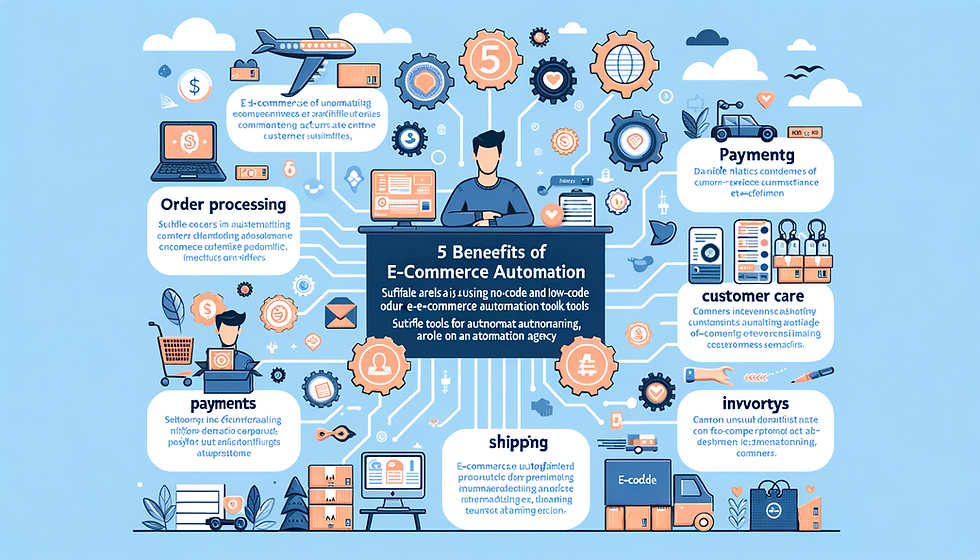How to automate order processing and fulfillment in your E-commerce store
- Federico Donati
- Mar 1
- 4 min read
Updated: Mar 5

E-commerce businesses thrive on efficiency. Every order placed triggers a chain of actions—confirmation emails, inventory adjustments, and shipping notifications. Managing these manually? A nightmare.
This is where no-code automation tools like Make.com, Shopify Flow, and Zapier step in. They streamline these tasks, ensuring customers stay informed and operations run smoothly. Let’s break down how you can automate your e-commerce fulfillment workflow—without writing a single line of code.
Automating Order Confirmations
The moment a customer places an order, they expect an immediate confirmation. A delay—even a few minutes—can create uncertainty. Instead of handling this manually, you can set up an automated workflow that triggers an order confirmation email the second a purchase is completed.
With Make.com, for example, you can:
Trigger: Detect a new order in your Shopify or WooCommerce store.
Action: Send an automatic email through Gmail, Mailchimp, or Klaviyo.
Additional Actions: Add the order to a Google Sheet for tracking or send a Slack notification to your team.
Why does this matter? Faster communication builds trust. Customers feel reassured knowing their purchase went through, and you eliminate the risk of missed confirmations.
Keeping Inventory Updated in Real Time
Inventory discrepancies lead to overselling, frustrated customers, and logistical headaches. Yet, many e-commerce businesses still update stock levels manually—an error-prone process.
With Make.com (formerly Integromat) or Zapier, you can:
Sync your e-commerce platform with your inventory management system (like Zoho Inventory or TradeGecko).
Automatically update stock levels when an order is placed.
Send alerts when stock falls below a threshold, prompting a reorder.
This type of real-time inventory automation prevents overselling, reduces manual work, and ensures customers always see accurate stock levels.
Shipping Notifications Without the Hassle
Once an order is packed and shipped, customers expect tracking details. Manually sending shipping notifications is inefficient. Automation ensures every customer gets their tracking link as soon as their order is on its way.
Here’s how you can set it up with Make.com:
Trigger: When an order’s shipping status updates in your e-commerce platform.
Action: Fetch tracking details from your shipping provider (e.g., UPS, FedEx, ShipStation).
Final Step: Send an email or SMS to the customer with tracking information.
Customers stay informed, reducing support tickets related to "Where’s my order?" inquiries. Your team can focus on growth instead of repetitive admin tasks.
Choosing the Right No-Code Tool for Your Store
Which tool is best for you? It depends on your platform and needs:
Make.com: Great for complex workflows requiring multiple steps and advanced logic.
Zapier: Best for connecting multiple apps, from email marketing tools to CRMs.
Shopify Flow: Ideal for Shopify users, offering deep integration with Shopify’s ecosystem.
Each tool eliminates the need for custom coding while ensuring seamless e-commerce fulfillment automation.
Scale Smarter with Automation
E-commerce success isn’t just about driving sales—it’s about efficient fulfillment. Automating order confirmations, inventory updates, and shipping notifications saves time, reduces errors, and enhances customer satisfaction.
Ready to streamline your operations? Let's get in touch today for a 30-minute free consultation 🚀
Frequently Asked Questions (FAQ)
1. What are the main benefits of automating eCommerce fulfillment?
Automating eCommerce fulfillment offers several key advantages:
Time savings: No more manual order confirmations, inventory updates, or shipping notifications.
Error reduction: Automation eliminates human mistakes in stock management and customer communication.
Improved customer experience: Instant confirmations and real-time tracking updates enhance trust and satisfaction.
Scalability: Handle increasing order volumes without hiring additional staff for repetitive tasks.
2. Which no-code tool is best for automating my eCommerce store?
The right tool depends on your platform and needs:
Make.com (formerly Integromat): Great for complex workflows requiring advanced logic, multi-step processes, or API integrations.
Zapier: Ideal for connecting multiple apps (e.g., email marketing, CRM, spreadsheets) with simple automation workflows.
Shopify Flow: Best for Shopify users who want deep integration with their store’s ecosystem.
3. How can I prevent overselling with automated inventory updates?
You can automate inventory management by syncing your eCommerce platform with an inventory system like Zoho Inventory or TradeGecko. Using tools like Zapier or Make.com, you can:
Automatically update stock levels: When an order is placed, reduce available stock in real time.
Create low-stock alerts: Get notified when a product reaches a predefined threshold to reorder on time.
Dynamically hide out-of-stock items: Prevent customers from purchasing unavailable products by automatically removing them from your store.
This ensures accurate stock levels across all sales channels while reducing manual work and errors.
4. What common mistakes should I avoid when setting up automation?
Avoid these pitfalls to ensure smooth automation:
Lack of testing: Always test workflows before deploying them live to catch errors early.
Poor error handling: Set up fallback actions (e.g., email alerts) if an automation fails due to missing data or API issues.
Inefficient workflows: Avoid unnecessary steps—keep automations streamlined for better performance and reliability.
No monitoring system: Regularly review logs and reports to ensure everything runs as expected over time.
5. How long does it take to set up eCommerce fulfillment automation?
The setup time depends on complexity:
Basic automations - order confirmations & shipping notifications: can be set up in under an hour using Make.com or Shopify Flow templates.
Intermediate workflows - inventory sync & low-stock alerts: takes a few hours if integrating multiple systems like ERP software or third-party logistics providers (3PLs).
Advanced setups - custom API integrations & multi-step processes: might require days of configuration and testing, especially if using Make for complex logic flows.



Comments